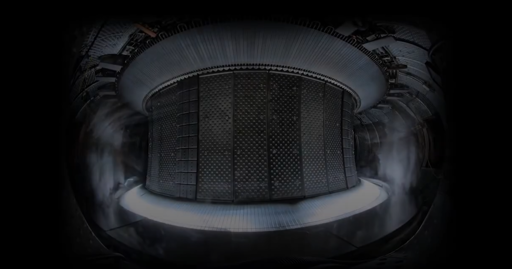1,337 seconds

Le et

Flexing
Flexing is not good for the containment
No, but some guy proved that we could use that to our advantage. If you don’t use the magnetic constrictors to compensate for the heat from the fusion expanding the vessel, you can have it enter fusion and leave fusion several times a second. Wrap the thing in copper wire coils, and you have now got your vessel in a state of flux, and producing enough power to blackout your local grid, and get lots of fines from the feds in less than 5 seconds of runtime. He obviously didn’t continue working on that particular method of generating power with a Tokomak
Can you link to something so I can read more about this please?
Wish I could. Only reason I know about it, is that it was mentioned briefly in the Navy Nuclear Power Program training materials.
Rumor is next they are trying for 11.6858˙3 hours
5,318008 seconds should be a new goal.
A headline without calling it an “Artificial Sun”?!
The power of the sun in the palm of my hand.
@Toribor @notsoshaihulud with great power comes great responsibility
Don’t worry, it will stabilize
The amusing thing is that the sun is actually quite a shit fusion reactor. It’s power per unit volume is tiny. It just makes it up in sheer volume. A solar level fusion reactor would be almost completely useless to us. Instead we need to go far beyond the sun’s output to just be viable.
It’s like describing one of the mega mining dumper trucks as an “artificial mule”.
I think this energy density math really depends on whether only the core or the whole surface area is taken into consideration.
Even the core only has an output of 200-300W/m^3.
That’s about the energy output per volume of a 70 year old cyclist.
Right, for the Americans here that hate metric.
Cyclist-years is a unit that has served us well for generations
Arguably, the nearby sun scale fusion reactor has been fairly useful for us. Nowadays we can convert its output directly into electricity using solar cells
I never said it wasn’t useful, just a very low efficiency reactor. Then again, if it was better, it would burn out faster, which would be bad for life on earth.
It produces about the same power per cubic metre as compost does, which is pretty crazy when you think about it.
What I’m hearing is that we should mine the sun and make better use of all that fuel.
Just make sure you do it at night.
Someone once told me a sun is just a fusion nuclear pile reactor and… Like… I guess.
They say “artificial sun” because that’s what it is though, there’s no fusion reactions here they’re just microwaving hydrogen to millions of degrees to study the kind of thing that would happen IF somebody runs a fusion reactor for 22 minutes.
Or a “star in a bottle”
A bulb in a bong
Meanwhile in America we’re trying to make macdonalds cheaper by bundling an extra sandwich to go along with a value meal…
That’s called McFusion
And it only takes 22 seconds to consume.
And only 12 seconds to regret.
Which means you are still consuming the burger for 10 seconds fully regretting your decision.
110% commitment to the burger and the regret. USA! USA!
That’s way better than Taco Bell, where the regret sinks in when you consider going there.
Spoken like someone who’s never had a cheesy gordita crunch
And keeps you sated for another 22 seconds.
Then you want seconds.
America would blow up a fusion reacto, call it dangerous, elon musk has a lot of things to say about it and then it would be illegal worldwide. Have you guys heard about coal? We already fixed it, just burn coal.
When the fuck did maccas start doing a sandwich?
Day one? A hamburger is a sandwich.
That was such a culture shock when I went to the us for the first time.
In Germany and many places in Europe do not think of burgers as sandwiches. I was so confused when I ordered a sandwich and got something like a burger.

I expected something like this. My confusion must’ve been quite the sight, the waitress even seemed concerned. Tasted great though.

The power of the sun in the palm of my hand
la puissance du soleil dans la paume de ma main
Honhonhon
[Takes a drag on a sexy cigarette]
But I’m le tired.
Well have a nap
The only reason to pursue fusion power research is so you can say this on a weekly basis. Any benefits to humanity are purely secondary.
How big are your hands???
It’s not the size the matters, it’s the amount of hands that matters.
Maybe if it runs longer, we all get to jump to a better timeline. 😅
Or the world blows up and it’s all over. I guess what I’m saying is, no downside, fire it up and let’s see what happens.
No tech will give you a better timeline, back on the floor please ^^ It’s a political problem before anything else, and energy production is far from being the first problem.
I’m sceptical. Even if somebody would present a working fusion reactor today, what would the timeline to replace everything based on fossil fuels even be? Build several thousand of expensive fusion reactors in every country of the world, even in geopolitical rivals like China, Russia or North Korea or war-torn third world countries? Replace every car with an electrical one? Replace home heating everywhere? Rebuild every ship and airplane worldwide?
If there were a practical fusion reactor shown today, it’d be 10 years before it could be started to be deployed at commercial scale.
More to the point, fascism isn’t going away just because we have better electricity sources. Cheap power is a problem in capitalism.
But pushing for more renewables can also be a way to stop fascism. Those texan oil barons are funding Trump exactly because they want to keep their business. Putin is funding all those right wing parties because he wants to keep selling gas. And the Saudis, Qataris and other dictators are also not to keen on not selling oil and gas.
Techbros are ready to pick up where the oil barons left off. Finding capitalists to fund fascism is never a problem.
Why don’t we use “shatters world record” like the pro-China articles where they did this for 16 minutes?
I know why.
I know!
Because the articles were written by different people and published in different magazines ya goober.
Nah.
It’s because of the Chinese propaganda machine.
Because that one was over double the length of the record before it and this one is closer to a 35% increase.
So it’s probably just a “slams”
‘Boinks’
whopping
France bamboozles chinas nuclear reactor time with a steel chair
Why do you care so much what an article says about France’s accomplishments of science and China’s accomplishments of science? Why can’t we enjoy the movement of technology without bickering about lines drawn in the sand by people none of us know or care about?
Dumbass lol
They’ll never tell.
Is it because of the Uyghurs?
This is freaking awesome. Only a few years ago it was exciting to see a fusion reaction last a fraction of a second.
It is awesome. Whichever country develops it first will be remembered as the next ‘moon landing’ event forever.
So a big event without any practical relevance because there is more cheaper, reliable and safer alternatives available?
People fall off rooftops fitting solar panels, burn to death repairing wind turbines that they can’t climb down fast enough to escape, and dams burst and wash away towns. Renewable energy is much less killy than fossil fuels, but per megawatt hour, it’s comparable to nuclear, despite a few large incidents killing quite a lot of people each. At the moment, over their history, hydro is four times deadlier than nuclear, wind’s a little worse than nuclear, and solar’s a little better. Fission power is actually really safe.
The article’s talking about fusion power, though. Fission reactions are dangerous because if you’ve got enough fuel to get a reaction at all, you’ve got enough fuel to get a bigger reaction than you want, so you have to control it carefully to avoid making it too hot, which would cause the steam in the reactor to burst out and carry chunks of partially-used fuel with it, which are very deadly. That problem doesn’t exist with fusion. It’s so hard to make the reaction happen in the first place that any problem just makes the reaction stop immediately. If you somehow blew a hole in the side of the reactor, you’d just get some very hot hydrogen and very hot helium, which would be harmless in a few minutes once they’d cooled down. It’s impossible for fusion power, once it’s working, not to be the safest way to generate energy in history because it inherently avoids the big problems with what is already one of the safest ways.
cheaper,
Once commercial fusion comes out, it’s likely to be about half the cost of wind.
[more] reliable
There’s absolutely no way to know how reliable human-generated fusion is, but it powers every star in the sky for billions of years, so it could probably last for a few decades here on Earth without much trouble.
and safer alternatives
Nuclear fusion, when begun, creates water as its byproduct. This water is, admittedly, very slightly radioactive; if you drank the “nuclear waste” that is produced by a fusion plant as your only source of water, it would increase your radiation exposure the same as if you flew from New York to Los Angeles and back once per year. Now, that’s not nothing, but it is almost nothing.
As for large-scale disasters from nuclear fusion, that’s almost impossible—and you can see why by the fact that this very article is news. With a nuclear fission reaction, the difficulty is in containment; get the right things in the right place, and the reaction happens automatically. There are natural nuclear fission reactors in the world, caves where radioactive materials have formed in an arrangement that causes a nuclear reaction. But in order for nuclear fusion to happen on its own, you need, quite literally, a stellar mass. So if something goes wrong in a fusion power plant, where we’re manufacturing the conditions that make fusion possible at great energy cost and effort, the reaction just stops unless there’s a literal sun’s worth of hydrogen hanging around. It cannot go critical, it cannot explode, it cannot break containment; it can only end. It’s hard to sustain a fusion reaction, and that’s why stories like this are news: because it’s a major breakthrough anytime we get closer to a reaction where we can feed enough power that it generates back into the machines that keep it running. Once the power to those machines is cut, a fusion reaction cannot continue.
Wait, what is the cheaper alternative to the moon landing?
Rovers as opposed to humans. Humans need food, a pressurized, temperated air environment, a discharge for their excrements, a higher level of safety and return mechanisms, much stronger radiation protection…
The space race gave us space age materials and advances. It wasn’t for nothing.
So much has manifested in the ripple effects from the pursuit of great things.
Oh shit. Things are heating up in the fusion race.
IIRC it was expected because previous record from China was essentially a trial for this one. It all happens under ITER project so it’s not that much of a race.
Good shit. I’d rather this be a global cooperative effort rather than a jingoistic dick-waving contest.
It’s several cooperative and competitives projects. Diversity is not bad for science anyway. ITER itself involve tons of countries.
Good. The only thing that was
quiteremotely good about the cold war was the competition.That’s not what this is, and even then, that competition wasn’t even good. You had two countries hoarding technological advancements for themselves, with everything having to be discovered twice.
This is a worldwide collaboration, where each assists the others, and it’s a much better way of making progress. See ITER.
I should’ve replaced ‘quite’ with a more clear ‘remotely’ but you’re absolutely correct
Mr. Fusion now 1 step closer… 10 years late, but still!
Only ten more years, and we’ll have it!
…you said 10 more years 50 years ago
In just 10 more years, it’ll only be 40 more years!
I feel like the awesome back to future reference was missed completely.
So, some as graphene.
We’re using graphene! Almost entirely for it’s electrical properties true, but we’re using graphene doped batteries in consumer electronics currently. We also use fusion and ITER research for a whole lot more than just power generation - plasma dynamics, just one tiny subfield concerned with physics, has applications in everything from radio transmission beam forming techniques to satellite engines to magnetodynamic modeling to the EMI shielding on your vacuum cleaner.
I would like to subscribe for more graphene facts.
Has DOGE cut funding to ITER yet?
They sacked everybody. Now they are trying to get them back.
/s
But only the white middle aged men with regular male names and above average height.
What about my racist and misogynist views I try to hide underneath my crazed and incompetent rantings about DEI? Is there room for someone like me?
You are now leading the department.
I didn’t see any mention of the output in the article. 22MW injected, but does anyone know if the reaction was actually generating a positive output?
No magnetic confinement fusion reactor in existence has ever generated a positive output. The current record belongs to JET, with a Q factor of 0.67. This record was set in 1997.
The biggest reason we haven’t had a record break for a long time is money. The most favourable reaction for fusion is generally a D-T (Deuterium-Tritium) reaction. However, Tritium is incredibly expensive. So, most reactors run the much cheaper D-D reaction, which generates lower output. This is okay because current research reactors are mostly doing research on specific components of an eventual commercial reactor, and are not aiming for highest possible power output.
The main purpose of WEST is to do research on diverter components for ITER. ITER itself is expected to reach Q ≥ 10, but won’t have any energy harvesting components. The goal is to add that to its successor, DEMO.
Inertial confinement fusion (using lasers) has produced higher records, but they generally exclude the energy used to produce the laser from the calculation. NIF has generated 3.15MJ of fusion output by delivering 2.05MJ of energy to it with a laser, nominally a Q = 1.54. however, creating the laser that delivered the power took about 300MJ.
I’ve seen a few mentions of positive output in the last few years.
OK, so we should be clear there are broadly two approaches to fusion: magnetic confinement and inertial drive.
In magnetic confinement a plasma is confined such that it can be driven to sufficient density, temperature and particle confinement time that the thermal collisions allow the fuel to fuse. This is what the OP article is talking about. This Tokamak is demonstrating technologies that if applied to a larger the experiment could probably reach a positive energy output magnetically confined plasma.
The article you referenced discusses inertial drive experiments, where a driver is directly pushing the fuel together, like gravity in the sun, a fission bomb shockwave in a hydrogen bomb, or converging laser beams in Livermore’s case.
Livermore’s result is exciting, but has no bearing on the various magnetic confinement approaches to fusion energy.
Aha, thank you for clarifying. Not my area of expertise, did not know the difference.
I wasn’t aware of that distinction about the energy for the laser to generate the heat energy within the reaction not being factored into the Q value, very interesting, thank you! Would that energy for the laser still be required in a “stable reaction” continuously, or would it be something that would “trail off”?
In my experience the community will usually distinguished between “scientific Q” and “wall plug Q” when discussing fusion power gain. Scientific is simply the ratio of power in vs power out, whereas wall plug includes all the power required to support scientific Q. Obviously the difference isn’t always clearly delineated or reported when talking to journalists…
Inertial confinement doesnt produce a “stable reaction” it is pulsed by it’s nature, think of it in the same way as a single cylinder internal combustion engine, periodic explosions which are harnessed to do useful work. So no the laser energy is required every single time to detonate the fuel pellet.
NIF isnt really interested in fusion for power production, it’s a weapons research facility that occasionally puts out puff pieces to make it seem like it has civilian applications.
Your take is incorrect.
It would be more productive if you said how you think im wrong. Just saying ‘youre wrong’ doesnt really add anything to the discussion.
The input energy doesnt matter that much. Nobody is going to use 1980s laser tech to power a real reactor. As with OP, inertial confinement is interested in very small nuanced science aspects, not making a power plant.
Sounds like the goal of the test wasn’t to vet ignition power in relation to output. These people are testing the durability of system designs that can maintain a reaction after ignition.
If this was a car, they wouldn’t be testing the fuel efficiency, they’d be testing how long they could drive before the wheels fell off.
1,337 seconds? That… that number used to mean something, but now i can’t recall what…
I still use 1337 sometimes, for joke names like 1337h4xX0r, or I use 1337 where others would use 42 or 69, but it’s always that nobody gets it. How could past internet culture vanish like that?
All your base are belong to us
Move zig move zig move zig, you know what you doing take off every zig!
The translation has been lost to the ages
HNNNGG, right in my nostalgia.
Time for another reread I suppose.
Found someone who can help.
Hahaha thank you for this gift
It used to be better. The subtitles were all in 13375p34k if you turned them on, but it looks like they got replaced by the YouTube automated subtitles at some point.
It’s still there as an option:
Zulu - 1337Oh, glorious!
1 I>0|\|+ |<|\|0\/\/
1337, leet, elite
Shh, don’t let the kids hear you say that
1337 SP33K iz 8USSin 0n 90d phr phr
How ks the drill baby drill crowd going to compete against mini stars in a can?
Lmao. Fucking oil losers
Idk dude, we already have the sun and wind but they hate that stuff too, despite it being very close to free. Hell they’ll probably bitch about fusion causing a surplus of power outside peak loads.
If it doesn’t perpetuate the broken ways we currently do things it doesn’t give their buddies money, so it’s woke or something else bullshit.
Plastic Straws. Plastic cups. Wrapping indvidual food items in plastic and then putting them in a larger plastic bag which you carry home in an even larger plastic bag.
The food has been impregnated with microplastics as well. This machine runs on sugar, but someone put oil in the tank. :-/
The ironic thing is the human body runs on fat and a huge portion of our illness stems from the insane amount of sugar we consume.
https://www.youtube.com/watch?v=cST99piL71E&list=PLE8LmUoWei5Qp5Nz7C4FMNs6hGNx7M3Jg&index=2
Summary: In 1984 our group published the first modern study of the effects of adapting to a low carbohydrate high fat diets on athletic performance. I have spent the next 31 years expanding on this research. In my presentation I will present the results of that research program and conclude with our exciting new evidence for the role of low carbohydrate diets and ketosis in the prevention of whole body inflammation in athletes training daily at very high loads. I will also present evidence to show that elite ultra-endurance athletes have an unexpectedly high capacity to oxidize fat during exercise and so potentially to run at fast paces for prolonged periods without the need to ingest exogenous fuels.
The 1928 Bellevue Stefansson Experiment McClellan W, et al. JBC 87:651,1930 http://www.jbc.org/content/87/3/651.f… Keto-adaptation Demonstrated Vermont Study Phinney et al JCI 66:1152, 1980
Thanks for sharing. As a frequent cyclist who loves cheese and doesn’t drink soda or eat many sweats, I feel like this will be an interesting read.
Well, if I lived in the world of American liberals and conservatives I was taught about growing up, the game would be over the moment fusion power became cheap, and everybody would be happy.
In the real world though? We’ll wait way too long, then get excited when it finally starts to happen, and then right before The Big Day some smooth brained asshole will blow up part of the reactor or fly a plane into the facility or something.
How ks the drill baby drill crowd going to compete against mini stars in a can?
Nu-Cu-Lar Bad? That’s…about as far as they’ll make it. To be fair, that might be as far as they need to. It’s all the oil companies will approve of them learning, at least.
Of course, it sounds like the big problem of how to remove more power from it than you spend keeping it reacting remains an issue, presuming they can continue to extend reaction lifetimes to be functionally unlimited.
I suppose we’ll need to worry about that, once we get a net positive output from a fusion reactor.
I hope it smoked a cigarette once it finished.
Amazing news!





























